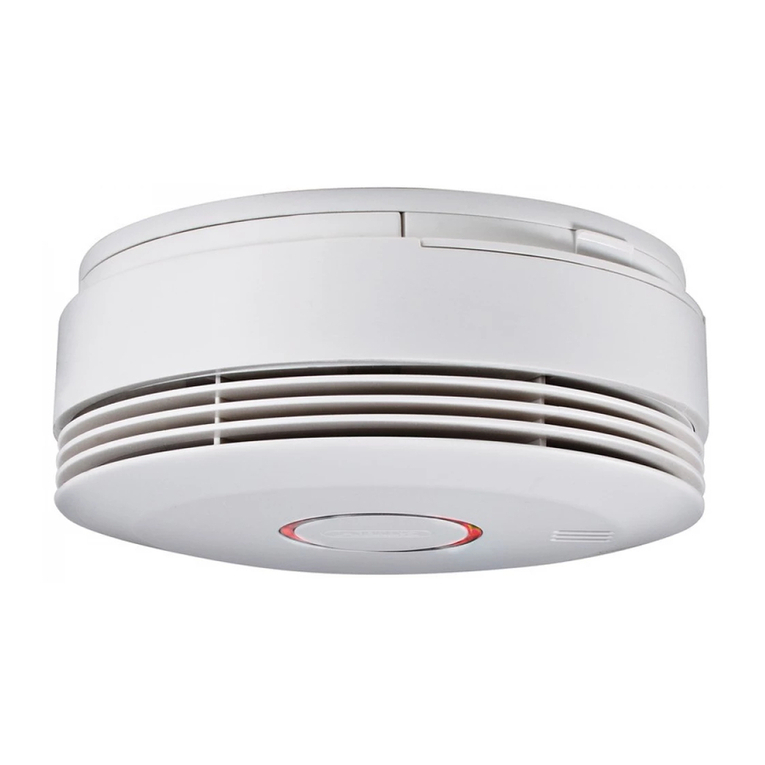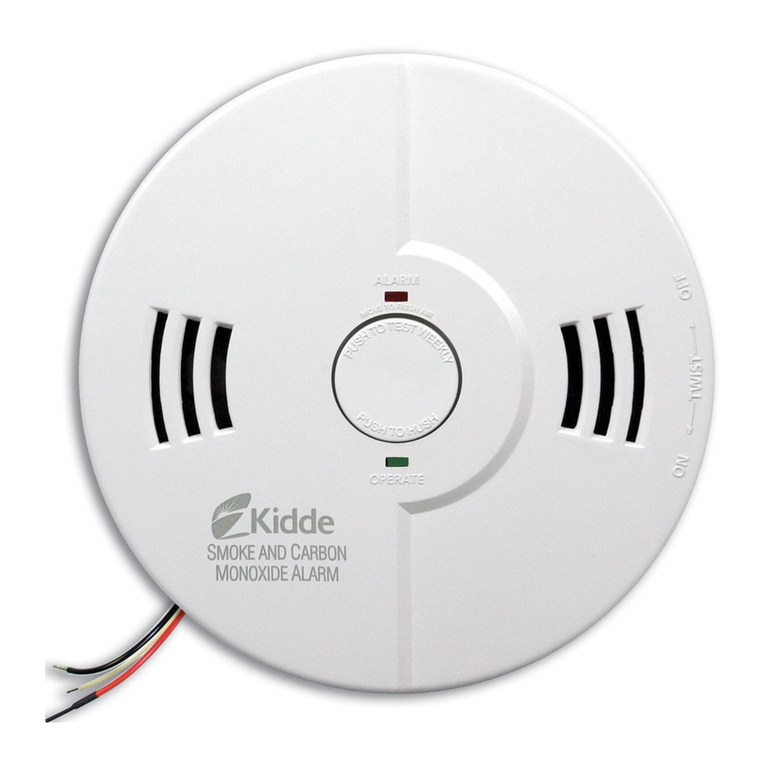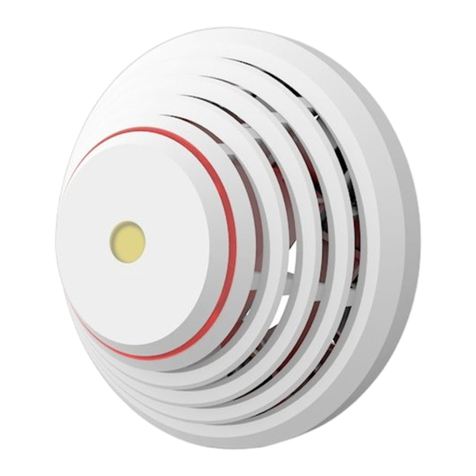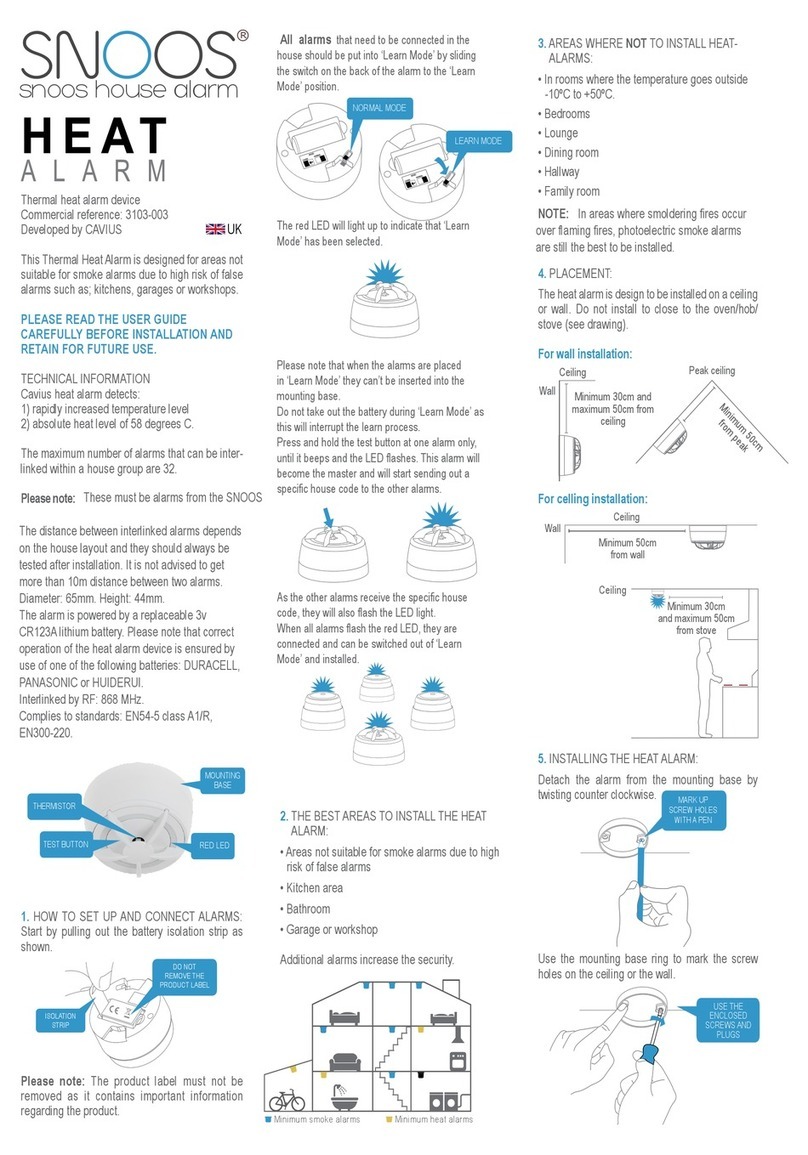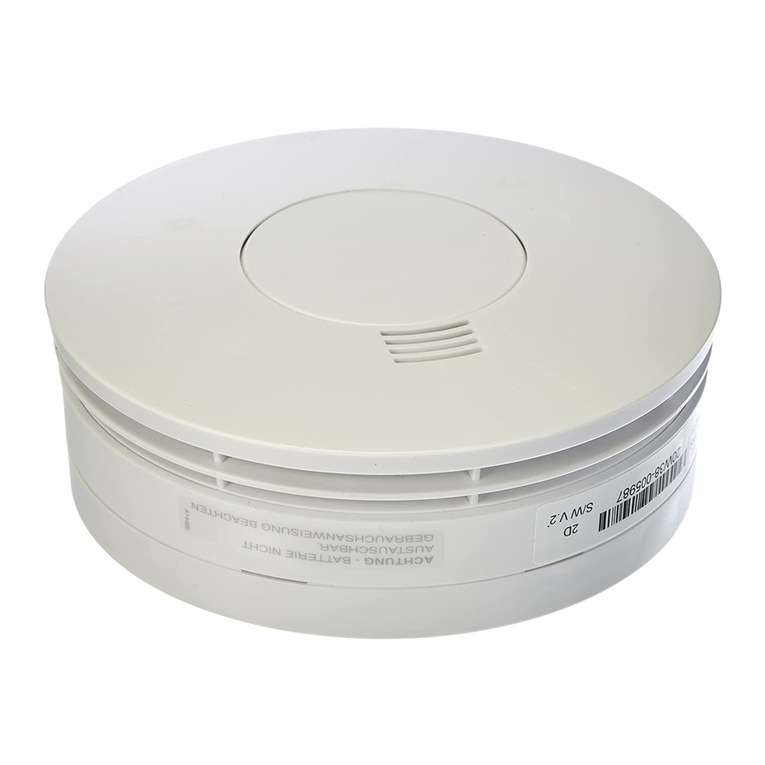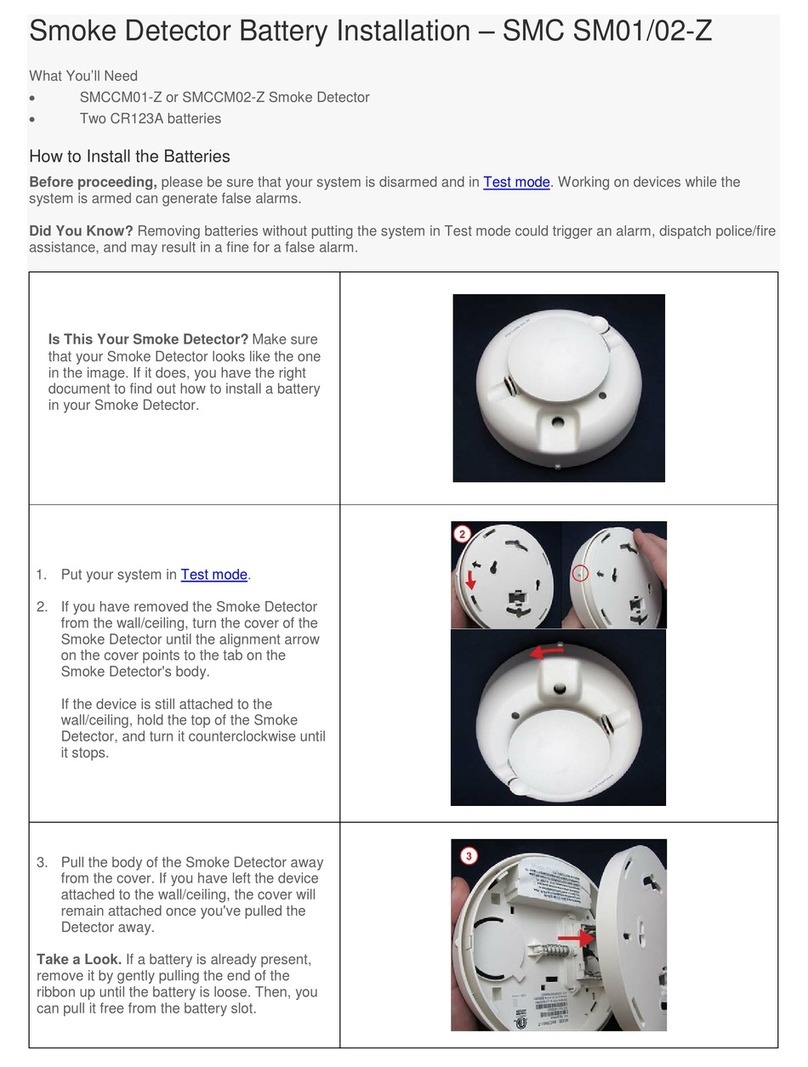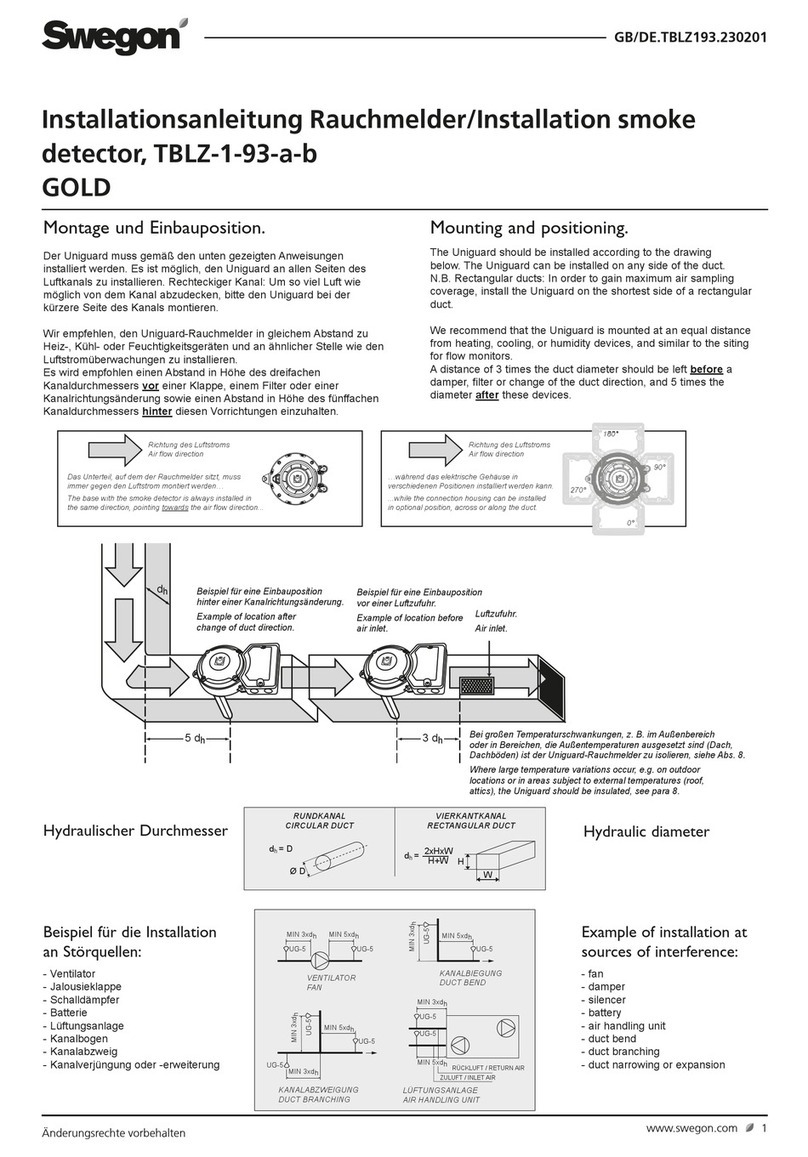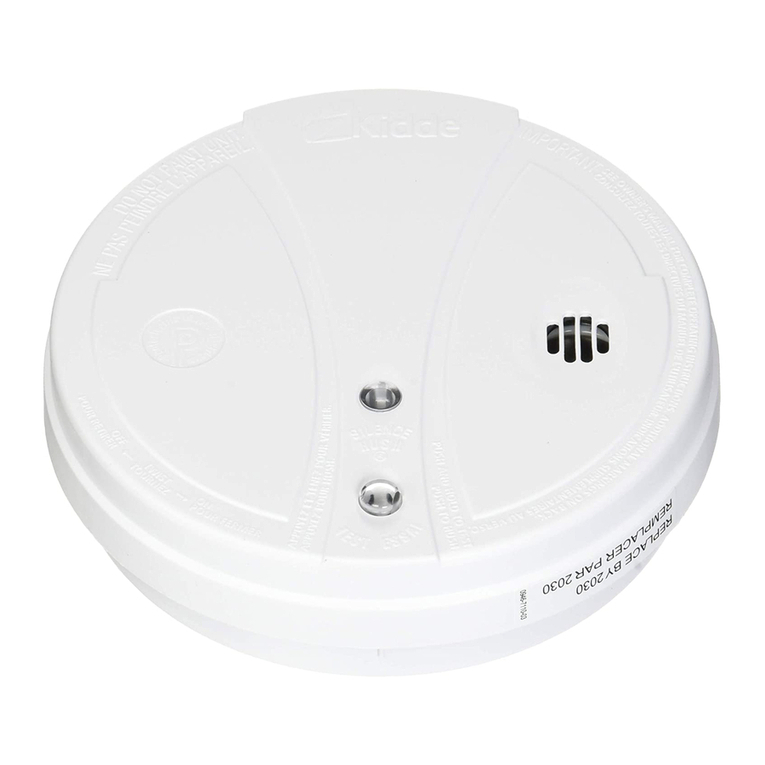Bentel Security FC400P User manual

ITALIANO
1. INTRODUZIONE
Il rilevatore ottico di fumo FC400P fà parte della serie di rilevatori incendio indiriz-
zabili FC400.
ØFC450IB Base con Isolatore
Ø5B 5” Base Universale
Il software all'interno della centrale è usato per interpretare i valori ottico e termico
in arrivo e attivare l'allarme o un altro tipo di azione secondo la tipologia del rileva-
tore configurato nella Fire Class 500 Console.
+Nota: Le regolazioni normali e ad alta sensibilità rispondono ai requisiti EN54-7
(vedere il paragrafo 1.1.1).
1.1 LOGICA DEL RILEVATORE
Il rilevatore ottico di fumo può essere impostato nel modo logico seguente:
1.1.1 MODO NORMALE
Nel funzionamento in modo normale il rilevatore genera un allarme quando viene
raggiunta la soglia d'intervento.
1.2 COMMUTAZIONE DELLA SENSIBILITÀ
Ciò può essere fatto da un'azione dell'utente per evento oppure periodico (esem-
pio, commutazione giorno/notte). Il cambio della sensibilità viene fatto spostando il
livello di uno verso l'alto o verso il basso.
2. PRINCIPIO DI FUNZIONAMENTO
L'art. FC400P funziona percependo, tramite un sensore ottico, l'espandersi delle
particelle di fumo generate in un incendio. Mentre la diffusione ottica del rilevatore
dà buone prestazioni di rilevazione per la maggior parte degli incendi, in alcuni in-
cendi rapidi dove il fumo prodotto è poco visibile, oppure il fumo è molto scuro, la
rilevazione, da parte del rilevatore di diffusione ottica, non è assolutamente facile. (
Tali incendi sono rappresentati nella norma EN54-7 rispettivamente da incendi
tipo Poliuretano e Eptano ). Questi incendi producono un'elevata emissione di ca-
lore con un innalzamento della temperatura dell'aria. Il rilevatore è stato progettato
per fornire una migliore rilevazione di tali incendi, analizzando il rapido tasso di au-
mento della temperatura dell'aria ed incrementando, in queste circostanze, la sen-
sibilità di rilevazione fumo.Questo permette un'individuazione tempestiva di tali
incendi e maggiori posibilità di rilevazione rispetto ad un rilevatore standard.
2.1 SISTEMA OTTICO
L'art. FC400P rileva le particelle visibili prodotte negli incendi, usando le proprietà
di diffusione della luce delle particelle. Il sistema ottico usato dal rilevatore è visua-
lizzato nello schema in Fig.1. Il sistema ottico è composto da un emettitore e da un ri-
cevitore infrarosso, entrambi hanno delle lenti sistemate frontalmente in maniera che il
ENGLISH
1. INTRODUCTION
The FC400P optical smoke detector forms part of the FC400 Series Addressable
Fire detectors.
ØFC450IB Isolator Base
Ø5B 5” Universal Base
Software within the controller is used to interpret the returned optical and heat val-
ues to raise alarm or other appropriate response according to the type of detector
configured in Fire Class 500 Console.
+Note: Normal and High sensitivity settings meet the requirements of EN54-7
(see para 1.1.1).
1.1 DETECTION LOGIC
The optical smoke detector can be selected in one logic mode as follows:
1.1.1 MODO NORMALE
In the normal detection mode, an alarm is generated when an alarm threshold is
reached.
1.2 SENSITIVITY SWITCHING
This can be done either by user action or be event or time driven (eg, day/night
switching).Changing the sensitivity is done by shifting the sensitivity by one level
up or down.
2. OPERATING PRINCIPLE
The FC400P operates by sensing the optical scatter from smoke particles gener-
ated in a fire.While the optical scatter detector can give good detection perfor-
mance for the majority of fires, some fast burning fires produce little visible smoke
and some produce very black smoke, neither of which are easily detected by the
optical scatter detector. (Such fires are represented in EN54-7 by Polyurethane
and Heptane type fires respectively).These fires do however produce high heat
outputs with an associated rise in air temperature. The detector has been de-
signed to offer improved detection of such fires by detecting the rapid rate-of-rise
of air temperature and under these conditions increasing the smoke detection sen-
sitivity.This gives an earlier detection of such fires and a broader detection capabil-
ity than a standard detector.
2.1 OPTICAL SYSTEM
The FC400P detects visible particles produced in fires by using the light scattering
properties of the particles.The detector uses the optical arrangement shown dia-
grammatically in Fig.1. The optical system consists of an infra-red emitter and re-
ceiver, with a lens in front of each, so arranged that their optical axes cross in the
FC400P
®
ISO 14001
9191.BNT2
ISO 14001
IT-52588
ISO 9001
9105.BNT1
ISO 9001
IT-52587
RILEVATORE OTTICO DI FUMO INDIRIZZABILE
ADDRESSABLE OPTICAL SMOKE
ISTSUBL3FC400P 0.0 251007
EMETTITORE
EMITTER
LENTE
LENS
VOLUME DI CAMPIONAMENTO
SAMPLING VOLUME
LENTE
LENS
ELEMENTO FOTOSENSIBILE
PHOTO DETECTOR
SCHERMI
BAFFLES
Schema camera ottica FIG.1Optical Chamber Schematic

loro asse ottico attraversi il volume di campionamento. L'emettitore, con la relativa len-
te, produce uno stretto fascio luminoso che non può raggiungere il ricevitore a causa
degli schermi. Quando del fumo è presente nel volume di campionamento parte della
luce si diffonde raggiungendo il ricevitore. Per un dato tipo di fumo, la luce che raggiun-
ge l'elemento fotosensibile è proporzionale alla densità del fumo.
2.2 CARATTERISTICHE DELLA CAMERA DI ANALISI
L'art.FC400P usa una particolare copertura per escludere la luce ambientale. Il fumo inci-
dente sul rilevatore è incanalato all'interno dello stesso dalle alette della copertura ester-
na (vedere Fig.2) e dai passaggi attraverso il profilo sagomato. Il fumo deviato all'interno
della camera ottica, attraversa il volume di campionamento per poi andare verso l'uscita
dall'altro lato del rilevatore.
L'emettitore (vedere Fig.1) è
di tipo solido GaAIAs con
funzionamento vicino all'in-
frarosso (picco di 880 nm),
mentre il rilevatore è un fo-
todiodo al silicio. Questi di-
spositivi insieme alle loro
lenti collegate sono tenuti
insieme dalla prolilatura del-
la camera. Il progetto del si-
stema ottico è tale che, la
presenza di piccoli insetti,
quali i tripidi, non deve cau-
sare falsi allarmi.
2.3 DESCRIZIONE DEL CIRCUITO
2.3.1 OTTICO
L'emettitore genera impulsi ogni volta che il rilevatore è attivato dalla Centrale,
questo riduce la corrente di riposo. L'impulso ottico del segnale ricevuto dall'ele-
mento fotosensibile (un segnale proporzionale alla diffusione all'interno della ca-
mera ottica) è alimentato dall ‘ASIC Ottico’. L'ASIC ottico amplifica il segnale
analogico introdotto da un'entrata analogica del circuito comune.
2.3.2 CIRCUITO COMUNE
Vedere Fig.3
Le comunicazioni tra la centrale ed il rilevatore usano il metodo di modulazione in
frequenza (FSK). Il ‘Circuito Discriminatore’ filtra il segnale FSK dalla linea di ten-
sione +ve e lo converte in forma d'onda quadra digitale utilizzata per la ‘Communi-
cazione ASIC’. La ‘Communicazione ASIC’ decodifica il segnale e quando
l'indirizzo è decodificato le entrate analogiche ricevute dagli elementi di rilevazione
ottica e termica sono convertiti in corrispondenti valori digitali. Questi valori digitali
vengono passati al ‘Circuito Tx Driver /Assorbimento corrente’ che li applica alla li-
nea +ve per la trasmissione alla centrale. Sul Circuito Comune è inoltre utilizzato:
ØContollo delle basi acustiche e relè tramite ‘Circuito d'Interfaccia della Base
Funzionale’ dai comandi della centrale.
ØControllo del funzionamento del LED Remoto tramite ‘Circuito LED Remoto’ dai
comandi della centrale.
2.4 COLLEGAMENTO
Il collegamento al loop è realizzato sui terminali base L (-ve) e L1 (+ve). Un aziona-
mento è fornito per un indicatore remoto collegato tra il positivo del loop ed il terminale
R. Il terminale L2 (uscita analogica) è utilizzato con le basi acustica funzionale e relè.
3. COSTRUZIONE MECCANICA
I maggiori componenti del rilevatore sono:
sampling volume.The emitter,with its lens, produces a narrow beam of light which
is prevented from reaching the receiver by the baffles.When smoke is present in
the sampling volume a proportion of the light is scattered, some of which reaches
the receiver. For a given type of smoke, the light reaching the photodetector is pro-
portional to the smoke density.
2.2 FEATURES OF MEASURING CHAMBER
The FC400P uses vertical chevrons to exclude ambient light. Smoke incident on the
detector is channelled into the detector by the outer cover fins (see Fig. 2) and
passes through the vertical chevrons.The smoke is deflected into the optical cham-
ber and through the sampling volume before passing out the other side of the detec-
tor.The emitter (see Fig. 1)
is a GaAlAs solid state
type operating in the near
infra-red (880nm peak),
while the detector is a
matched silicon
photodiode.These devices
together with their associ-
ated lenses are held in
place by the chamber
mouldings.The design of
the optical system is such
that the presence of small
insects such as thrips
should not cause false
alarms.
2.3 CIRCUIT DESCRIPTIONS
2.3.1 OPTICAL
The emitter is only pulsed every time the detector is polled from the controller, this
is to reduce quiescent current.The optical pulse signal as received by the
photodetector (a signal proportional to the scatter within the optical chamber) is fed
to the ‘Optical ASIC’.The optical ASIC amplifies the analogue signal which is fed to
an analogue input on the common circuit.
2.3.2 COMMON CIRCUIT
Refer to Fig. 3
Communications between the controller and detector uses the Frequency Shift
Keying (FSK) method.The ‘Discrimination Circuit’ filters the FSK signal from the
+ve line voltage and converts it to a digital square wave input for the ‘Communica-
tions ASIC’. The ‘Communications ASIC’ decodes the signal and when its own ad-
dress is decoded, the analogue inputs received from the optical and heat sensing
elements are converted to corresponding digital values.These digital values are
then passed to the ‘Tx Driver Circuit/Current Sink’ which applies them to the +ve
line for transmission to the controller. The Common Circuit is also used to:
ØControl Sounder and Relay bases via the ‘Functional Base Interface Circuit’
from controller commands.
ØControl the operation of the Remote LED via the ‘Remote LED Circuit’ from con-
troller commands.
2.4 WIRING
Loop cabling is connected to base terminals L (-ve) and L1 (+ve). A drive is pro-
vided for a remote indicator connected between loop positive and terminal R.Ter-
minal L2 (analogue output) is for use with functional sounder and relay bases.
3. MECHANICAL CONSTRUCTION
The major components of the detector are:
PERCORSO DEL FUMO
SMOKE PATH
VOLUME DI CAMPIONAMENTO
SAMPLING VOLUME
ALETTE
FINS
Camera di Analisi e percorso di flusso del fumo FIG.2Measuring Chamber Showing Smoke Flow Path
ELEMENTO FOTOSENSIBILE
OPTICAL ELEMENT
CIRCUITO SENSORE OTTICO
OPTICAL SENSING CIRCUIT
ASIC OTTICO
OPTICAL ASIC
INTERFACCIA
COMUNICAZIONE ASIC
COMMUNICATIONS
ASIC INTERFACE
LOGICA SET/LATCH
DI ELABORAZIONE
DELL’INDIRIZZO
ADDRESS SET/LATCH
SIGNAL PROCESSING
LOGIC
STABILIZZATORE DI TENSIONE
VOLTAGE REGULATOR
CIRCUITO COMUNE
COMMON CIRCUIT
CIRCUITO DISCRIMINATORE
DISCRIMINATION CIRCUIT
CIRCUITO Tx DRIVER/
ASSORBIMENTO CORRENTE
Tx DRIVER CIRCUIT/
CURRENT SINK
CIRCUITO LED REMOTO
REMOTE LED CIRCUIT
CIRCUITO D’INTERFACCIA
DELLA BASE FUNZIONALE
FUNCTIONAL BASE
INTERFACE CIRCUIT
+VE LINEA IN/OUT
+VE LINE IN/OUT
-VE LINEA IN/OUT
-VE LINE IN/OUT
LED ALLARME
ALARM LED
BASE
BASE
FSKOUT
FSKIN
Schema a Blocchi Semplificato del Rilevatore FIG.3Simplified Block Schematic of Detector

ØBody Assembly
ØPrinted Circuit
ØOptical Chamber
ØOptical Chamber Cover
ØLight Pipe
ØOuter Cover
3.1 ASSEMBLY
The body assembly consists of a plastic moulding which has four embedded de-
tector contacts which align with contacts in the base.The moulding incorporates
securing features to retain the de-
tector in the base. The PCB is
clipped to the body by four spring
contacts.These contacts act as a
mechanical fixture during assem-
bly and provide electrical contact
between the contacts and the
PCB. The chamber cover is
clipped to the body over the opti-
cal chamber.The light pipe is slot-
ted into the chamber cover.
Finally, the outer cover is clipped
to the body.
4. TECHNICAL SPECIFICATION
4.1 MECHANICAL
Dimensions: The overall dimensions are shown in
Fig.5 ( less base ) .
Materials
Body,cover, and closure: FR110 ‘BAYBLEND’ flame retardant.
Weight
Detector: 0.076kg
Detector + Base: 0.14kg
4.2 ENVIRONMENTAL
Temperature
Operating: -25oC to +70oC
Storage: -40oC to +80oC
Relative Humidity: 95% ( non-condensing )
Shock:
Vibration: EN54-5 and EN54-7
Impact:
Corrosion: EN54-5 and EN54-7
4.3 ELECTROMAGNETIC COMPATIBILITY
The detector complies with the following:
Øproduct family standard EN50130-4 in respect of Conducted Disturbances, Radi-
ated Immunity, Electrostatic Discharge, Fast Transients and Slow High Energy;
ØEN61000-6-3 for emissions.
4.4 ELECTRICAL CHARACTERISTICS
The following characteristics (Table 1) apply at 25oC and nominal supply voltage of
37.5V unless otherwise specified.
Table 1: Electrical Characteristics
Characteristic Min. Typ. Max. Unit
Loop Voltage 20.0 -40 V
Quiescent Current -275 305 µA
Alarm Current* 33.3 mA
* No remote indicator fitted
4.5 PERFORMANCE CHARACTERISTICS
The FC400P detector, with its base, forms an addressable detector which trans-
mits signals representing the detector digital current levels to a remote control
unit.The control unit evaluates these signals against pre-determined criteria and
decides when an alarm condition has occurred. The information given below there-
fore relates to the performance of the as a transducer only, since the system alarm
response is determined by the control unit.
ØCorpo Assemblato
ØCircuito Stampato
ØCamera Ottica
ØCoperchio Camera Ottica
ØCondotto Ottico
ØCoperchio Esterno
3.1 ASSEMBLAGGIO
Il corpo assemblato è costituito da uno stampo in materiale plastico con quattro contatti
inseriti nel rilevatore allineati con i contatti della base. Lo stampaggio unisce e assicura il
mantenimento del rilevatore nella
base. Il PCB è fermato al corpo tra-
mite quattro contatti a molla. Questi
contatti fungono da fissaggio mec-
canico durante il montaggio stabi-
lendo un contatto elettrico tra i
contatti ed il PCB. Il coperchio della
camera è fermato al corpo sopra la
camera ottica.Il condotto ottico è
composto da una scanalatura all'in-
terno del coperchio della camera.
Infine, il coperchio esterno è fissato
sul corpo.
4. SPECIFICHE TECNICHE
4.1 MECCANICHE
Dimensioni: Le dimensioni generali sono indicate in
Fig.5 (meno la base).
Materiali
Corpo,coperchio e chiusura: FR110 ‘BAYBLEND’ ritardante fiamma.
Peso
Rilevatore: 0,076 Kg
Rilevatore + Base: 0,14 Kg
4.2 CARATTERISTICHE AMBIENTALI
Temperatura
Funzionamento: da -25 a +70 oC
Stoccaggio: da -40 a +80 oC
Umidità relativa:95% ( senza condensa )
Shock:
Vibrazione: EN54-5 e EN54-7
Impatto:
Corrosione: EN54-5 e EN54-7
4.3 COMPATIBILITÀ ELETTROMAGNETICA
Il rilevatore è conforme a quanto segue:
Øfamiglia di prodotto standard EN50130-4 nel rispetto dei Disturbi Condotti, Immunità
Irradiata, Scarica Elettrostatica, Transitori Rapidi e Alta Energia Lenta;
ØEN 61000-6-3 per le emissioni.
4.4 CARATTERISTICHE ELETTRICHE
Le seguenti caratteristiche (Tabella 1) si applicano alla temperatura di 25oC e alla
tensione nominale di alimentazione di 37,5 V salvo diverse specifiche.
Tabella 1: Caratteristiche elettriche
Caratteristica Min. Tip. Mass. Unità
Tensione Loop 20,0 -40 V
Corrente a Riposo -275 305 µA
Corrente in Allarme* 33,3 mA
* Senza indicatore remoto
4.5 CARATTERISTICHE DI PRESTAZIONE
Il rilevatore FC400P, con la base, forma un rilevatore indirizzabile il quale trasmette i
segnali che rappresentano i livelli digitali correnti alla centrale di controllo. La centrale di
controllo valuta e confronta questi segnali con i criteri di taratura e decide quando si ve-
rifica una condizione d'allarme. Le informazioni fornite di seguito si riferiscono quindi
alle prestazioni dell'art.FC400P soltanto come trasduttore, poichè la risposta del siste-
ma di allarme è determinata dalla centrale di controllo.
Sezione e Vista Superiore del Rilevatore FIG.4Sectioned and Top View of the Detector
Dimensioni Generali del Rilevatore FC400P FIG.5Overall Dimensions of FC400P Detector

4.5.1 RESPONSE TO SMOKE
The response of an optical smoke detector is
normally measured with reference to the
obscuration produced by smoke.Obscuration is
measured in percent per metre, or in dB per
metre.The latter unit is used in EN54-7 and is
designated ‘m’. Unfortunately, there is no fixed
relationship between optical scattering and
obscuration, the ratio between them being de-
pendent on the type of smoke. For convenience,
‘grey’ smoke is normally used but white and
black smokes give more or less scattered light
respectively for a given obscuration level.The
working of the FC400P is a linear function of
obscuration for a given type of smoke as shown
graphically in Fig. 6.
5. DETECTOR IDENTIFICATION
The detector is identified by the logo label
colouring as shown in Fig. 7.
6. DETECTOR ADDRESS
The loop address of the detector is held in inter-
nal E2PROM which is programmed either from
the controller or by an FC490ST Loop Service
Tool.
7. ADDRESS FLAG
Refer to Fig. 8. The address flag is used
to identify the address and zone of the de-
tector.The address flags are supplied in a
packs (address 1 - 255, with a different
colour for each loop) and are ordered
separately from the detector.The address
flag is fitted to the bottom of the detector.
When the detector is fitted to the base
and turned until fully located’ the address
flag is then transferred to the base.If the
detector is removed from the base, the
address flag remains with the base.
8. ORDERING INFORMATION
FC400P Photo Smoke.
5B 5” Universal Base.
FC450IB 5” Isolator Base.
9. RECYCLING INFORMATION
BENTEL SECURITY recommends that customers dispose of their used
equipments (panels, detectors, sirens, and other devices) in an environmentally
sound manner. Potential methods include reuse of parts or whole products and re-
cycling of products, components, and/or materials.
For specific information see
www.bentelsecurity.com/en/environment.htm
10. WASTE ELECTRICAL AND ELECTRONIC EQUIPMENT
(WEEE) DIRECTIVE
In the European Union, this label indicates that this product should
NOT be disposed of with household waste. It should be deposited at
an appropriate facility to enable recovery and recycling.
For specific information see
www.bentelsecurity.com/en/environment.htm
BENTEL SECURITY s.r.l. reserves the right to change the technical specifications
of this product without prior notice.
4.5.1 RISPOSTA AL FUMO
La risposta di un rilevatore ottico di fumo è nor-
malmente misurata in riferimento all'oscuramento
prodotto dal fumo. L'oscuramento è misurato in
percentuale per metro, o in dB per metro. La se-
conda unità è usata nella norma EN54-7 ed è indi-
cata con ‘m’. Purtroppo non sussiste una
relazione fissa tra la diffusione ottica e l'oscura-
mento, il rapporto tra di loro dipende dal tipo di
fumo. Per convenzione viene normalmente consi-
derato il fumo ‘grigio’, ma il fumo bianco o scuro
dà rispettivamente più o meno luce diffusa per un
dato livello di oscuramento. Il funzionamento del-
l'art. FC400 dipende in maniera lineare dall'oscu-
ramento per un dato tipo di fumo, come visibile sul
grafico in Fig.6.
5. IDENTIFICATIVO RILEVATORE
Il rilevatore è identificato dall'etichetta del logo
colorato visibile in Fig.7 .
6. INDIRIZZO DEL RILEVATORE
L'indirizzo di loop del rilevatore è inserito all'inter-
no della E2PROM ed è programmato dalla centra-
le o dallo strumento di programmazione dei
dispositivi indirizzabili FC490ST.
7. LINGUETTA INDIRIZZO
Vedere Fig.8 . La linguetta indirizzo è
usata per identificare l'indirizzo e la zona
del rilevatore. La linguetta indirizzo è for-
nita in confezioni ( indirizzi 1-255, con un
differente colore per ogni loop )ed è ordi-
nabile separatamente dal rilevatore. La
linguetta indirizzo è in dotazione con la
parte inferiore del rilevatore. Quando il ri-
levatore è posizionato sulla base e ruota-
to fino al collocamento, la linguetta
indirizzo và trasferita sulla base.Se il rile-
vatore viene rimosso dalla base, la lin-
guetta indirizzo rimane sulla base.
8. INFORMAZIONI PER L'ORDINE
FC400P Ottico di Fumo.
5B 5” Base Universale.
FC450IB 5” Base con Isolatore.
9. INFORMAZIONI SUL RICICLAGGIO
BENTEL SECURITY consiglia ai clienti di smaltire i dispositivi usati (centrali, rile-
vatori, sirene, accessori elettronici, ecc.) nel rispetto dell'ambiente. Metodi poten-
ziali comprendono il riutilizzo di parti o di prodotti interi e il riciclaggio di prodotti,
componenti e/o materiali.
Per maggiori informazioni visitare
www.bentelsecurity.com/it/ambiente.htm
10. DIRETTIVA RIFIUTI DI APPARECCHIATURE
ELETTRICHE ED ELETTRONICHE (RAEE - WEEE)
Nell'Unione Europea, questa etichetta indica che questo prodotto
NON deve essere smaltito insieme ai rifiuti domestici. Deve essere
depositato in un impianto adeguato che sia in grado di eseguire opera-
zioni di recupero e riciclaggio.
Per maggiori informazioni visitare
www.bentelsecurity.com/it/ambiente.htm
BENTEL SECURITY s.r.l. si riserva il diritto di modificare le specifiche tecniche di
questo prodotto senza preavviso.
OSCURAMENTO : m-VALORE
OBSCURATION : m-VALUE
FUNZIONAMENTO DELL’USCITA(BITS)
WORKING OUTPUT (BITS)
Grafico FC400P FIG.6Graph FC400P
ROSSO
RED
Identificativo Rilevatore FIG.7Detector Identification
INCAVI DI BLOCCAGGIO
RETAINING DEPRESSIONS
RIENTRANZA DI MONTAGGIO
MOUNTING RECESS
PARTE SAGOMATA A ´D`
´D` SHAPED PART
CANALE SAGOMATO A ´U`
´U` SHAPED CHANNEL
SPORGENZE DI BLOCCAGGIO
RETAINING PIMPLES
Inserimento della Linguetta Indirizzo FIG.8Fitting Address Label Carrier
Other Bentel Security Smoke Alarm manuals

Bentel Security
Bentel Security ZT100P User manual
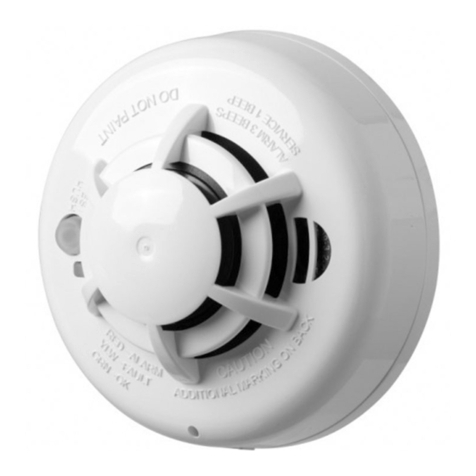
Bentel Security
Bentel Security ASD30 User manual
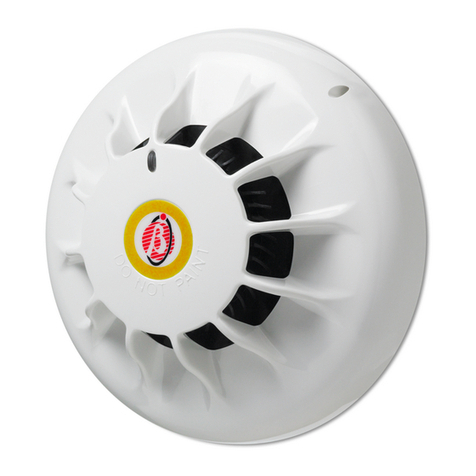
Bentel Security
Bentel Security 601PH User manual
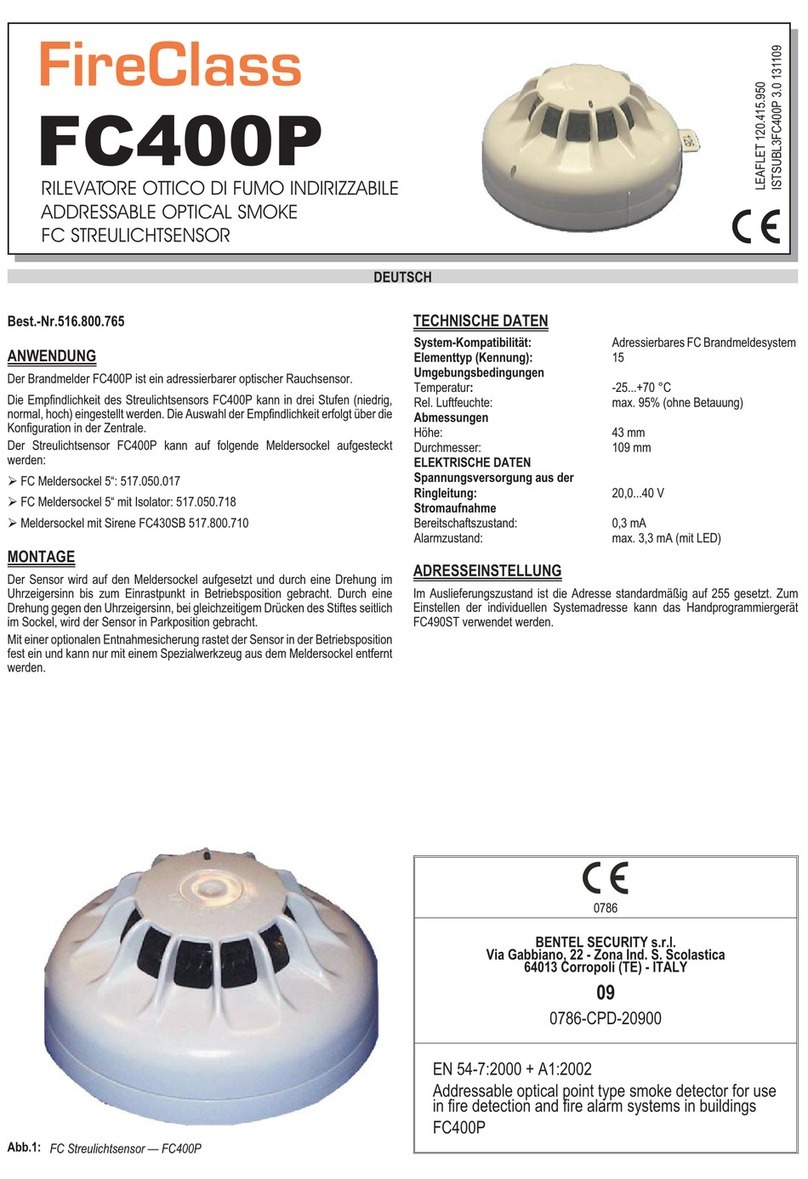
Bentel Security
Bentel Security FireClass FC400P User manual

Bentel Security
Bentel Security RF 501t User manual
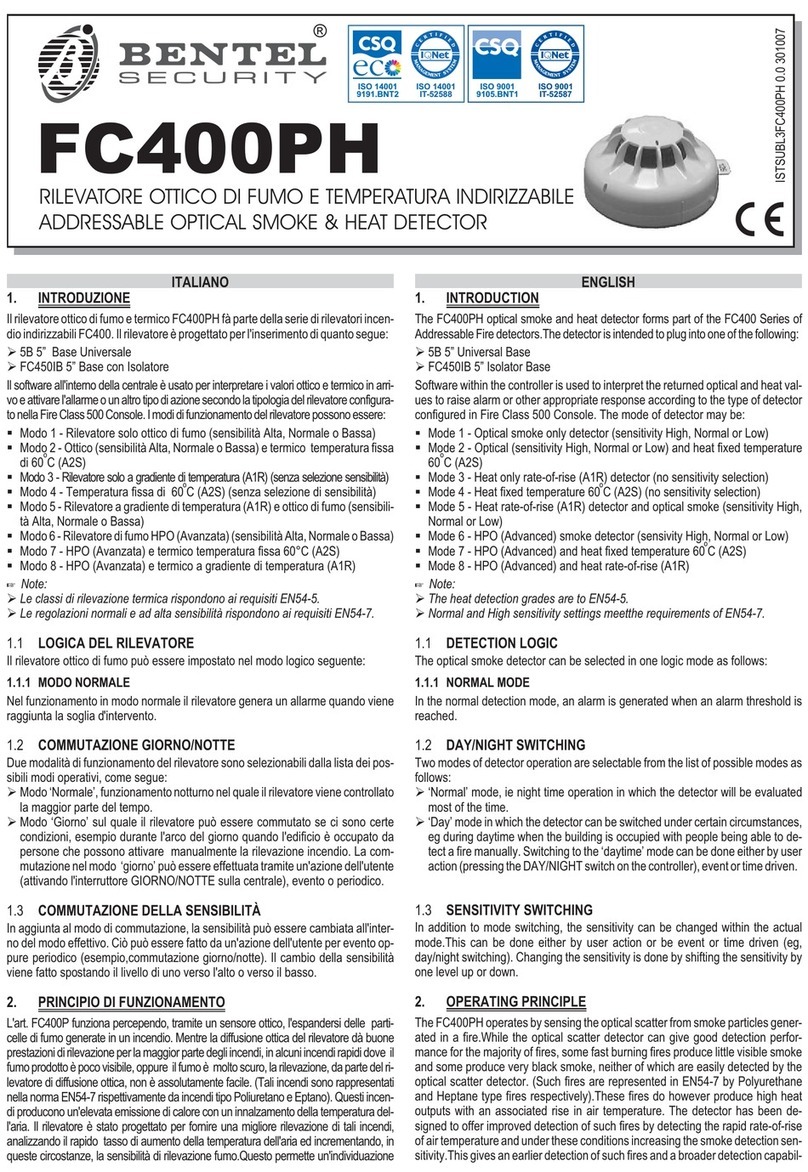
Bentel Security
Bentel Security FC400PH User manual
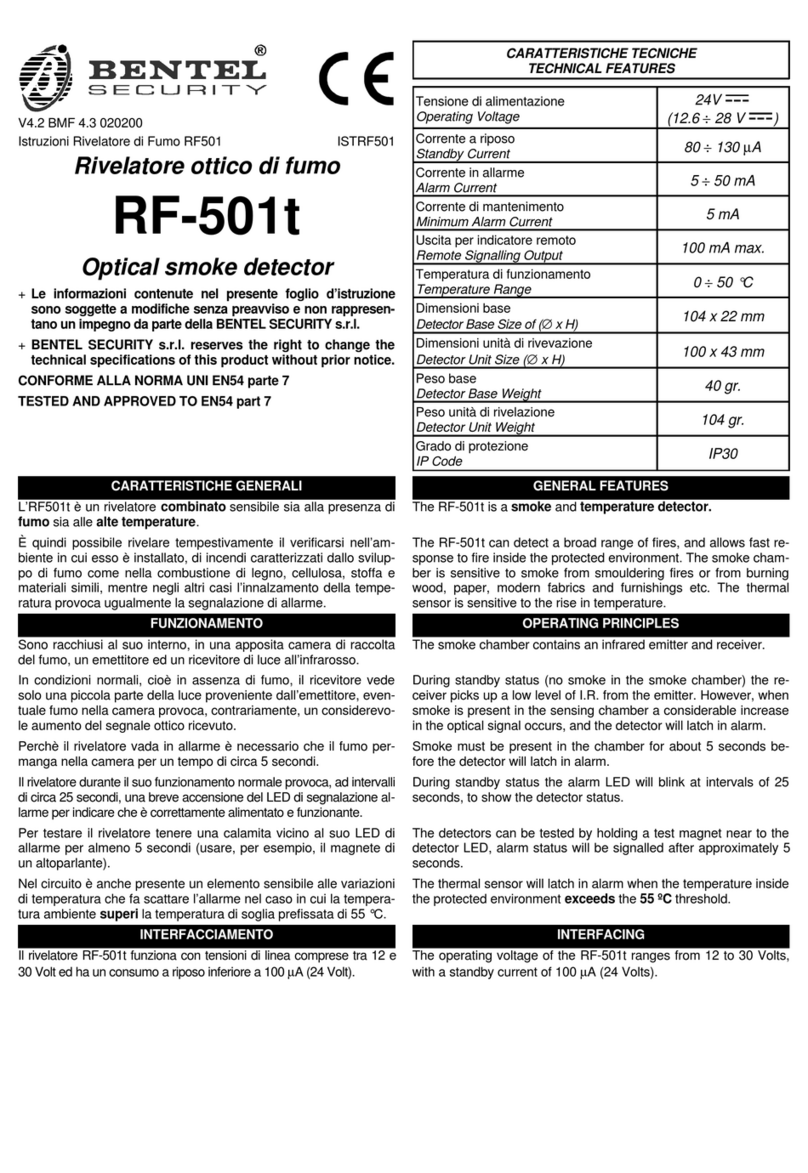
Bentel Security
Bentel Security RF-501t User manual
Popular Smoke Alarm manuals by other brands
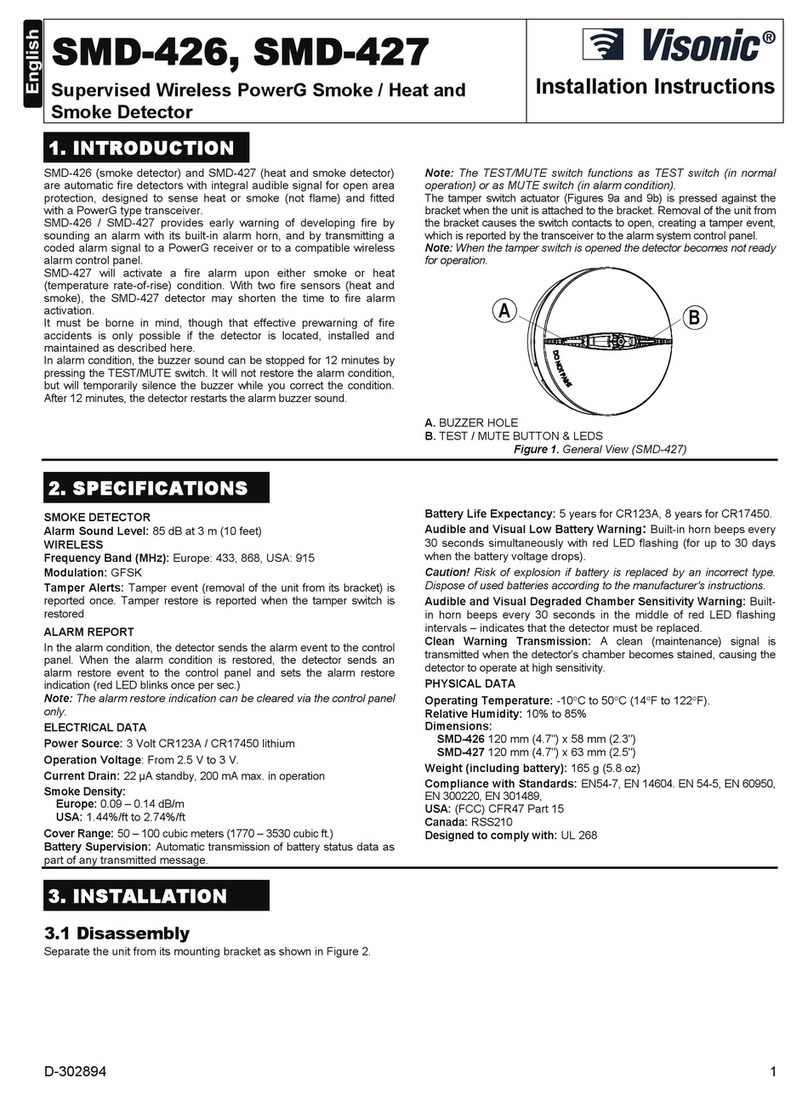
Visonic
Visonic SMD-426 installation instructions

ESP
ESP PSD212 installation manual

Siemens
Siemens DELTA reflex SD230N Operating and mounting instructions
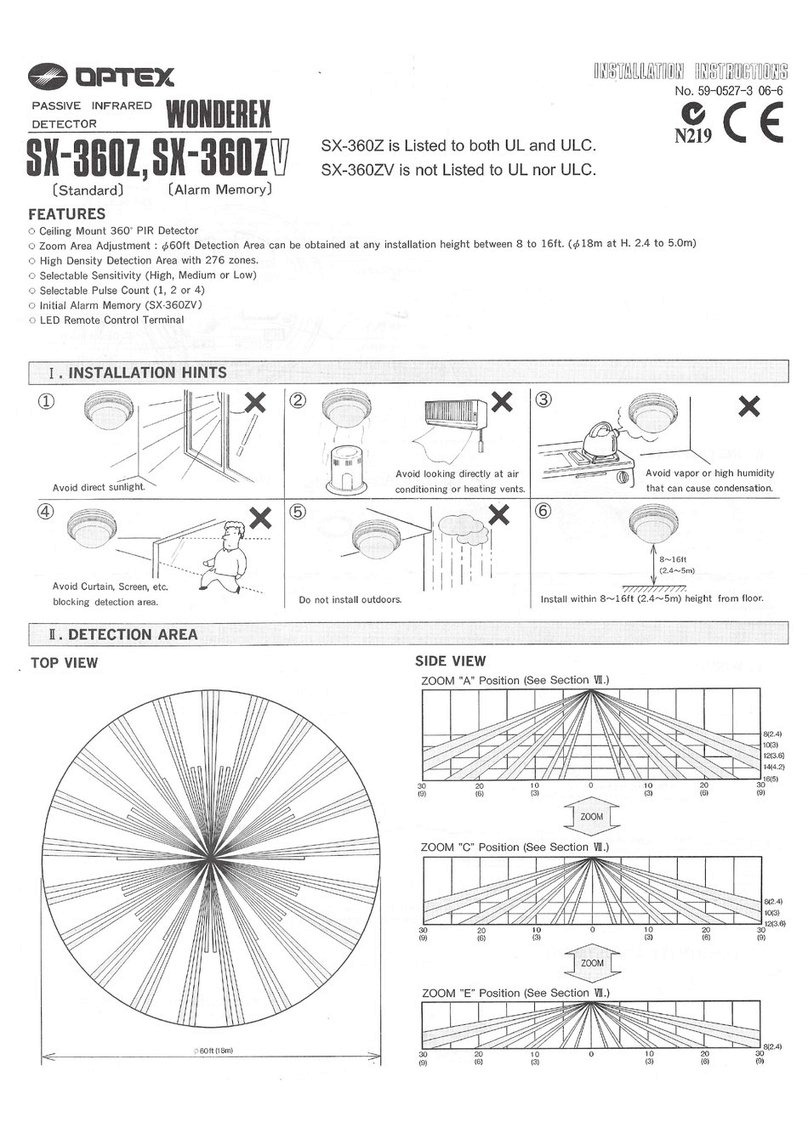
Optex
Optex SX-360Z installation instructions
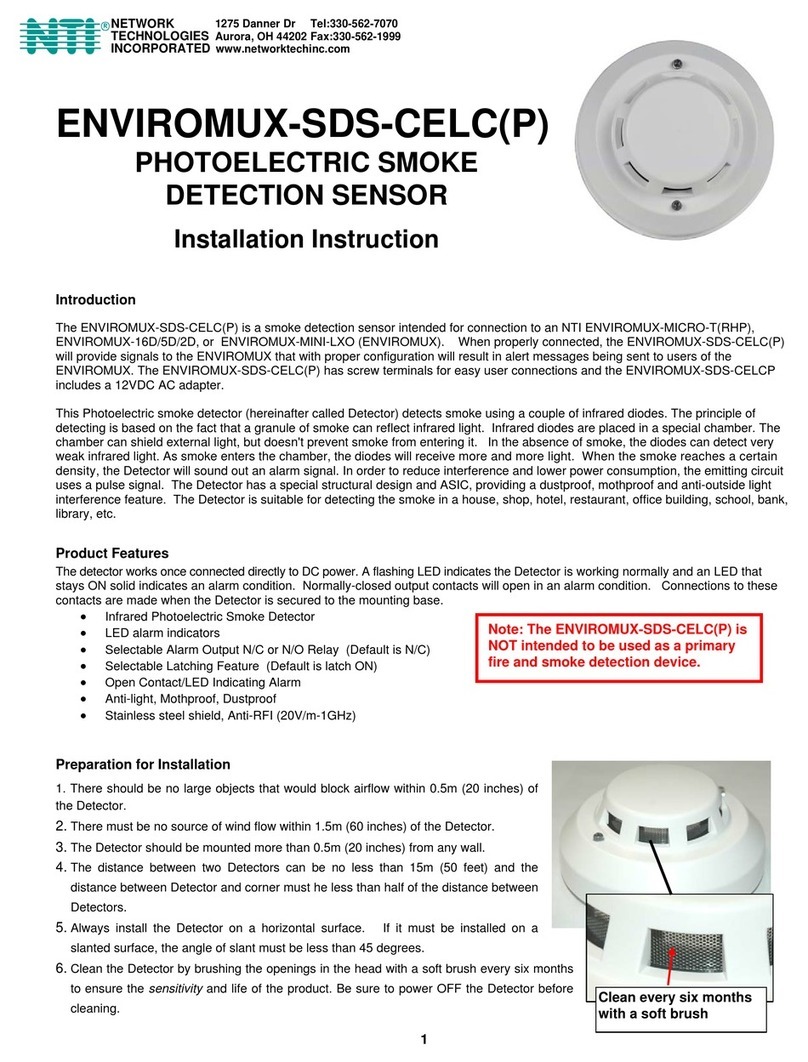
Network Technologies Incorporated
Network Technologies Incorporated ENVIROMUX-SDS-CELC Installation instruction

Elkron
Elkron SD200 manual
